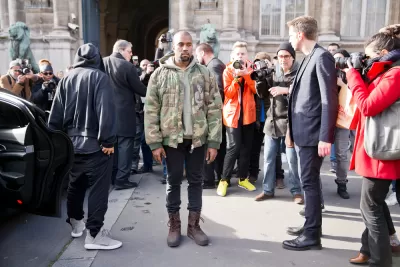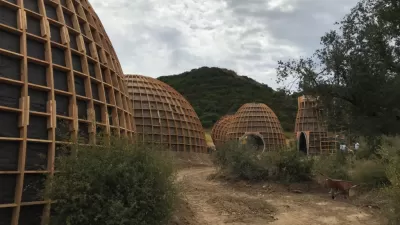Kanye West's first foray into the development business is off to an inauspicious start.

At the end of July, news got around that Kanye West had built some "Star Wars"-looking structures on 300 acres he owns in Calabasas in Southern California.
"Sources familiar with the project tell TMZ ... Kanye is building dome-like structures that are prototypes for a new type of home ... homes he believes will break the barriers that separate classes ... namely, the rich, the middle class and the poor," according to an article on TMZ dated July 31.
A lot of sites picked up the news: Vice, Slate, Forbes, Dwell. The idea seemed to be building momentum from an idea first pitched a year ago under the auspices of the company Yeezy Home architecture studio. In an interview filmed in May 2018, West talked about his ambitions to become, "one of the biggest real-estate developers of all time, what Howard Hughes was to aircrafts and what Henry Ford was to cars…."
Since the first appearances of the domed structures on West's property in Calabasas, however, "several neighbors have complained to the L.A. County Department of Public Works," according to a follow up TMZ article, posted on August 5.
Now West has 45 days to submit plans to the county and get building permits, or else. "The 'or else' -- tear them down," reports the article.
TMZ has also been doing some old fashioned gumshoe reporting on the subject, filling in these details on the developing story:
"A source close to Kanye tells TMZ ... the structures were always intended to be temporary, because they're simply prototypes. The source says they are in touch with the County and intend to comply with the requirements. And, the source adds, the concrete base was necessary to secure the structure for safety and structural reasons but will eventually be removed along with the structures."
FULL STORY: DOME-LIKE STRUCTURES MAY BE TORN DOWN ... Violate Building Code

Maui's Vacation Rental Debate Turns Ugly
Verbal attacks, misinformation campaigns and fistfights plague a high-stakes debate to convert thousands of vacation rentals into long-term housing.

Planetizen Federal Action Tracker
A weekly monitor of how Trump’s orders and actions are impacting planners and planning in America.

In Urban Planning, AI Prompting Could be the New Design Thinking
Creativity has long been key to great urban design. What if we see AI as our new creative partner?

King County Supportive Housing Program Offers Hope for Unhoused Residents
The county is taking a ‘Housing First’ approach that prioritizes getting people into housing, then offering wraparound supportive services.

Researchers Use AI to Get Clearer Picture of US Housing
Analysts are using artificial intelligence to supercharge their research by allowing them to comb through data faster. Though these AI tools can be error prone, they save time and housing researchers are optimistic about the future.

Making Shared Micromobility More Inclusive
Cities and shared mobility system operators can do more to include people with disabilities in planning and operations, per a new report.
Urban Design for Planners 1: Software Tools
This six-course series explores essential urban design concepts using open source software and equips planners with the tools they need to participate fully in the urban design process.
Planning for Universal Design
Learn the tools for implementing Universal Design in planning regulations.
planning NEXT
Appalachian Highlands Housing Partners
Mpact (founded as Rail~Volution)
City of Camden Redevelopment Agency
City of Astoria
City of Portland
City of Laramie





























